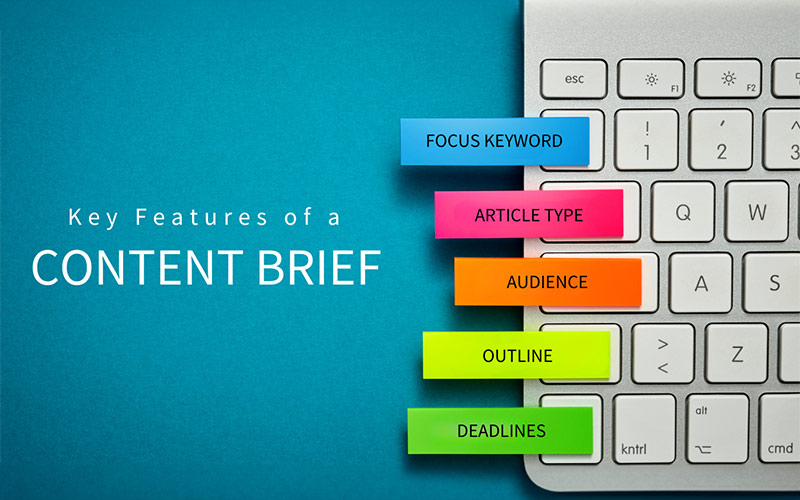By Daniel Duke – Here at Rellify, we’re pretty passionate about using content briefs. They’re an integral part of any content marketer’s process for delivering expert, relevant content to customers. But how exactly does a brief play into the overall content production process, and why does it matter so much? We’ll go over that here, covering:
- What is a content brief?
- How to write a content brief
- What are the benefits of a content brief?
What is a content brief?
A content brief is a document that describes what a client or editor wishes to see in an article, blog post or other piece of content. A brief contains the information a writer needs to efficiently complete the article envisioned by the person assigning it. An effective brief will include information about the client, target reader and essential elements of the article, and possibly an outline for article as well as useful sources. Even when the same person handles the planning, writing and editing, we recommend writing a thorough brief. Some might see this as a waste of time, but it’s more efficient overall to start out with a brief rather than write an article without one and then make revision after revision.
A good brief helps a writer:
- Stay on track. This is especially important when a business is creating many pieces of content as part of a campaign. In such cases, you don’t want multiple articles covering the same subject matter and competing against one another. You want each one to have maximum impact.
- Save time that might be wasted researching and writing unwanted material. This also saves time for editors and helps get material published sooner.
Writing a brief also forces the person assigning the article to develop a clear focus for it. Fuzzy, vague assignments can lead to fluffy, weak articles that won’t rank highly in organic search results.
How to write a content brief with Rellify
Let’s review how a brief is constructed to provide the maximum impact. For this walkthrough, we’ll use the Rellify application’s briefs process, but these concepts apply to any brief.
Focus keyword
This is the topic or “focus” of your article — the word or phrase you’re trying to rank for on search engines. All of your other keywords should relate to this term. The focus keyword guides the content’s relevance, aligning it with user search queries. There are many tools for finding focus keywords and then keywords for specific articles. Rellify can use a Relliverse™— an AI-generated database specific to a client’s business sector — to do keyword research. From there, it can detect the exact topics, keywords, and phrases that fit your brand and target audience’s search intent. It creates a customized neural network of keywords that, when used properly, can strategically position your content to get picked up by search engines. This is one of Rellify’s most advanced and groundbreaking features. However, you can still create an effective content brief in Rellify without it.
In Rellify, once you’ve done research in the “Explore” tab and entered your chosen focus keyword into the “Brief” section under “specs,” it guides the rest of your brief-building and content creation process.
Keyword research
Once you’ve found the right focus keyword, you’re ready to find primary and secondary keywords to incorporate into the brief.
Keyword research happens in the “Explore” tab, but once you’ve selected the keywords you’d like to include, they’ll show up in the “Brief” tab under the “Outline” section. The writer doesn’t have to use all the keyword suggestions, but rather the ones that most closely match the intent of the article. In the “Outline” section, you can indicate any keywords that you’d like the writer to know are “must-use” and “good to use.” Be clear in the guidelines of your brief about how many keywords you expect to be included.
Content length/Word count
By providing a target word count , you allow the writer to better manage their time and resources. Although word count is not considered to be a ranking factor for Google, if you want an article to help establish thought leadership and E-E-A-T, a comprehensive (and thus longer) article might be called for. Your ultimate goal should be to match the text length to the user’s intent and the nature of the topic, fully addressing it. At Rellify, we use artificial intelligence to analyze the top-ranking articles on your subject and recommend a word count in the brief tab under the “specs” section. With that recommendation in mind, you can still input whatever word count specifications you’d like within the text box.
Article type
Is this content meant to be a blog post? An in-depth guide? Is it a white paper that promotes or highlights your company’s product or solution? The brief should let your writer know exactly what you are looking for. It dictates the structure, style, and approach of the content, ensuring it aligns with the specific goals such as informing, getting leads, or entertaining the audience. In Rellify’s “specs” section, you’ll find a drop-down menu for “Article Type” where you can select accordingly.
Audience
This is a simple designation of who the reader is in relation to you, the content source. It’s not anything extensive, but it helps pointedly guide the writer. It may fall into one of three broad categories:

- B2B (Business to Business)
- B2C (Business to Consumer)
- C2C (Consumer to Consumer)
However, you can write a more detailed description of your intended audience, including information such as search intent, demographics, and locality.
Audience expertise
A brief should set clear expectations for who your target reader is. While the writer may be an expert, that doesn’t mean the reader will be. Tailoring the content to the level of audience knowledge improves its engagement and effectiveness. In Rellify’s Brief, under “specs,” you’ll find a section titled “audience expertise,” where you can select “general,” “informed,” or “expert.”
Tone
Every brand has a unique style or tone that informs its content creation. In-house writers should have this down pat, but a reminder doesn’t hurt. For freelance writers, direction on tone will be a big help — and probably save the editor a great deal of time and effort. It also helps to give a link or two to examples of writing that match the client’s tone. In Rellify, you can describe the tone in detail in the Brief.
Top rankings
Checking out the competition gives insights into the content strategies and styles that are currently successful and visible in search engine results. This helps editors and writers understand the competitive landscape, audience preferences, and potential gaps in existing content. Naturally, you would Google your focus keyword to see what results it gets. When you identify your focus keyword, Rellify automatically crawls search engines to find the top three web pages that are ranking for it. In the Brief “specs” section, you’ll find the links plus an AI-generated summary of the content.
Reading resources
You might trust writers to do their own research. However, if you come across good sources while writing a brief, it makes sense to pass along that information. It can help a writer avoid getting overwhelmed by the sheer volume of search results on your target keyword. You might save everyone a lot of guesswork by giving quality, directed background resources and detailed content information.
Outline
The background information has been set, now you can guide the structure of the article. You can write an outline based on what you see in competing articles, what ground you want to cover, and how you want to distinguish your article from the rest. The right structure, using subheads and bullet points to organize the material, makes it easier for readers and bots to gather information.
Here’s where Rellify’s generative AI capabilities really begin to work for the brief-maker. Under the “Brief” tab, click on the “Outline” button. You will then see, on the left side, the focus keyword, primary and secondary keywords, and questions to answer. On the right, you have a blank field labeled “outline.” To make full use of AI, you can create an outline with one click of the “Generate outline” button.
You also can manually create a content outline section by section, starting with the title, the “H1.” You can drag and drop keywords you would like to see in that introductory section. You also can write notes for what should be covered there. Then you proceed in the same way with subheadings — the “H2s” and “H3s.” In any section, you can get AI assistance with writing titles and subtitles and with generating text that can guide the writer.
The bottom line: you get to choose just how much you’d like to involve Rellify’s article intelligence in the content brief process. It’s totally customizable and can be altered according to the brief-maker’s thinking and goals.
Guidelines
You may have a few more instructions for a writer that didn’t fit into the other sections. That’s why, under the Brief tab, you’ll find a third section titled “Guidelines.” This is intentionally left blank so you can add background information or specific instructions. Or you can just write them a little note of encouragement or recognition for previous good work.
Suggested internal and external links
Linking is a huge part of SEO best practices. It’s essential to choose quality links to sources and include helpful “further reading” internal links. This information can be particularly helpful to a writer who doesn’t know much about the content on your site. Also, be sure to say how many internal or external links you expect them to include. If you have expectations of where links should go in the content, include that info too.
Suggested metadata
This is “data about other data.” Suggest a meta title and a meta description. Even if you want the writer to take care of that, your suggestions provide more guidance on your vision for the article. Rellify’s “article summary” feature uses generative AI to summarize any text you choose, which could be used for a meta description. You also can click an “AI support” button to general headlines.”
Any media content you need
A big block of text, no matter how well written, is not inviting to the eyes. Photos, infographic and videos create an immersive and rich user experience. Compelling visuals also are a great way to generate quality backlinks and help with your domain authority. Because visuals are so important, the brief should make it clear whether the writer is expected to provide them. If they are, then detailed information is required.
Deadlines
This information helps with timely planning, creation, and publication of the content. It also helps in managing workflow and resources effectively. Depending on your content creation process, you might want to include deadlines for the following steps:
- Keyword research
- Outline
- First draft
- Notes (if any)
- Revisions
- Approval
- Publication
What are the benefits of a content brief?
- Spells out the intent of the article. Content writers will do their best work when they’re given a complete picture of the article’s goal. It’s like looking at the picture on the front of the puzzle box as you put the pieces together. It helps tremendously with producing SEO-focused content.
- Identifies the reader’s needs. When people go to a search engine, they likely have a problem they’re trying to solve. Searchers may be looking for a particular product or just beginning to do research on ways to solve a problem. When a brief identifies the “problems” that are motivating searchers, it helps the writer craft relevant content that offers a solution.
- Improves efficiency. Even in a one-person content shop, writing a brief gets the writer/editor from idea to published content faster and more efficiently. Organization is a good writer’s bread and butter. Develop a content brief template to save time on any given project; you’ll only need to fill in certain information once because it’s the same for every article on a project. Establishing a good process with your content team or freelancers helps everyone get on the same page. This also can be very grounding for a writer trying to cover an unfamiliar subject.
- Helps with achieving goals and KPIs. KPIs reflect how well your content is doing. You want solid results on the metrics that best represent your company goals. Creating content briefs as part of a marketing strategy makes it much easier to achieve and measure the content performance goals you set for your content.
- Gets more mileage out of your content. Well-written, well-organized content has a better chance of being “evergreen.” This content doesn’t depend on current events for its relevance. It has the depth and lasting value needed to rank well in organic search results for years. And we all know that search engine algorithms change. When they do, an article crafted from a solid brief will need only minor tweaks, not an overhaul. A well-written — and well-structured — piece can easily be repurposed for email campaigns and other uses.
- Generates fully optimized content. Good content briefs include plenty of rich SEO keywords, directions regarding SEO best practices, and information about the intended audience. This all adds up to top-ranking articles. A well-directed, well-informed writer can do the majority of the SEO optimizing for you, especially with a Content Intelligence application like Rellify that tells you exactly what needs to be done.
Streamline content creation with content briefs
Are you ready to use content briefs to help your writers produce winning results? At Rellify, creating a pointed, clear, and detailed content brief is an essential part of our full-service content marketing strategy for producing outstanding results. Many clients have already noticed significant gains in organic traffic, conversions, and leads since using Rellify. Ready to give it a shot? Experience a free trial of Rellify’s Article Intelligence Application and explore the content brief process for yourself. If you’re not exactly sure which of Rellify’s services you need, schedule a consultation with one of our experts so we can tailor solutions to your specific goals.
About the author

Dan Duke’s extensive experience in the editorial world, including 27 years at The Virginian-Pilot, Virginia’s largest daily newspaper, helps Rellify to produce first-class content for our clients.
He has written and edited award-winning articles and projects, covering areas such as technology, business, healthcare, entertainment, food, the military, education, government and spot news. He’s worked under deadline pressure covering events such as the explosion of the Space Shuttle Challenger, the election of Barak Obama, the killing of Osama Bin Laden, the landfalls of hurricanes and, on a lighter note, the selection of the best chocolate chip cookie in Hampton Roads. He also has edited several books, both fiction and nonfiction.
His journalism experience helps him to create lively, engaging articles that get to the heart of each subject. And his SEO experience helps him to make the most of Rellify’s AI tools while making sure that articles have the specific information and voicing that each client needs to reach its target audience and rank well in online searches.
Dan’s leadership has helped us form quality relationships with clients and writers alike.

